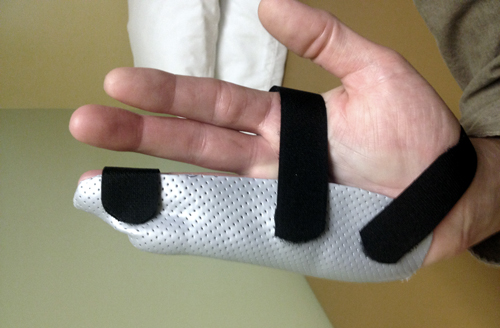
Most often occurring in men of Northern European descent older than 40 years of age, Dupuytren’s contracture results in the inability to bend the fingers, usually the ring and little fingers. Genetic factors are thought to play a role in Dupuytren’s disease; however, currently no link has been established. Risk factors may include manual labor involving vibration, prior hand trauma, alcoholism, smoking and diabetes mellitus. The disorder, whose cause is unknown, usually progresses slowly and is painless. It is often ignored until the fingers are so bent that they interfere with routine activities. The first sign of Dupuytren’s contracture is the development of a small, painless nodule or lump in the tissue below the skin on the palm side of the hand, often below the ring finger.
As the disorder progresses, the nodule thickens into a cord-like band, pulling the finger joints and bending the affected fingers toward the palm. Initially, the first knuckle is affected. If left untreated, the condition can spread to the second knuckle. At this point, the fingers become immobile and permanently bent toward the palm. Prior to 2010, the treatment choices for Dupuytren’s contracture were surgery to remove fibrous tissue or needle aponeurotomy to weaken it. Surgery is highly effective but can damage the nerves and blood vessels, and it requires extensive postoperative physical therapy. Needle aponeurotomy uses needles to puncture the contracting Dupuytren’s cord and thus weaken it until it can be broken by mechanical force, typically with a characteristic snap. Now, a nonsurgical treatment called enzyme fasciotomy is available. In this procedure, the physician injects an enzyme, collagenase clostridium histolyticum, into the cord. The enzyme weakens the cord so that it breaks, and the fingers are released. In the early stages of Dupuytren’s contracture, manual physical therapies, including stretching, the application of heat and massaging the hand and fingers to relax the fascia, have improved range of motion (ROM) and decreased tendon fibrosis. Deep tissue massage of the palm of the hand and fingers can help release the nodules and make the palmar fascia more mobile. Postsurgical physical therapy includes wound care, massage, passive stretching, active ROM exercises and splinting. Physical therapy is an appropriate treatment for Dupuytren’s contracture, before and after medical intervention. We can design an exercise program to help keep the fingers movable and avoid the subsequent development of scar tissue.









